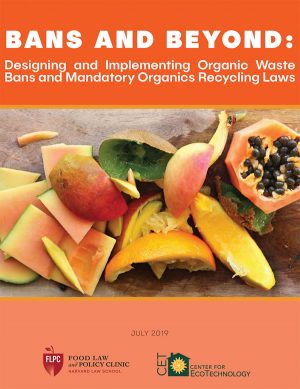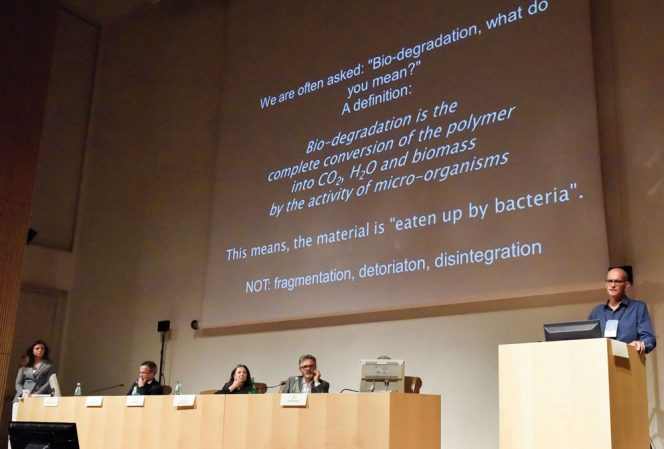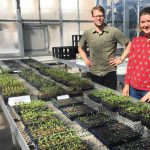BioCycle August 2019
Organic Waste Ban Report
The Harvard Food Law and Policy Clinic (FLPC) and Center for EcoTechnology (CET) released their toolkit, Bans and Beyond: Designing and Implementing Organic Waste Bans and Mandatory Organics Recycling Laws. The toolkit analyzes the structure and implementation of organic waste bans and presents examples from states and cities with existing or proposed waste bans. The authors examined the bans from a “holistic perspective,” analyzing the structure of organic waste ban laws as well as other factors including funding, infrastructure, enforcement, and education. “Together, these components can have a significant impact on how an organic waste ban policy will function in a given state or locality,” they note. BioCycle published an article last fall that gives a preview of the Toolkit.
Global Recycling Outlook
Following China’s ban on solid waste, including plastic, hardware, scraps of stainless steel, titanium and wood, countries are “considering localized circular economy for domestic waste recycling needs,” according to Frost & Sullivan’s recent analysis, Global Waste Recycling and Circular Economy Market Outlook, 2019. “The plastic recycling market is especially likely to experience high growth due to investments in new technologies, driving the $37.60 billion market towards $39.89 billion in 2019. Overall revenues in the global waste recycling market are expected to increase from $354.7 billion in 2018 to $376.9 billion in 2019, and the volumes generated are set to grow from 29,493.7 million metric tons to 30,190.0 million metric tons during the same period. The industrial segment generated the most waste (nonhazardous, 16,748.8 million metric tons) in 2019, whereas the total volume of plastic waste generated is 280 million metric tons.”
Among the MSW recycling trends noted in the report are reverse vending machines to tackle plastic packaging waste, increasing focus on diverting waste from landfills through recycling and Zero Waste targets, waste to methanol, and pay-as-you-throw as a business model. The Outlook highlights the recycling opportunities of different waste streams generated globally and the growth opportunities in countries affected by the waste import ban imposed by China.
Marine Biodegradability Of Compostable Plastic
Novamont, the Italy-based manufacturer of compostable plastics, posed this question to researchers: “What happens if — as unfortunately happens with the packaging of any material — a bag made of Mater-Bi is not recovered but is discarded into the natural environment?” To find answers, Novamont coordinated and funded research to evaluate the following: Intrinsic marine biodegradability (conducted at Novamont’s laboratory); Disintegration in the marine environment; and Ecotoxicity released into sediment as a result of biodegradation of fruit and vegetable bags made of Mater-Bi. According to a Novamont press release, its Mater-Bi plastics were analyzed by means of new internationally standardized biodegradation tests (UNI EN ISO 19679: 2018 method), “Plastics-Determination of aerobic biodegradation of non-floating plastic materials in a seawater/sediment interface-Method by analysis of evolved carbon dioxide”. This method involves exposing plastic samples to the microorganisms found in marine sediment and measuring the plastic’s transformation into carbon dioxide.
“The tests carried out at Novamont’s laboratories, some of which have been corroborated within the European Commission’s ‘Environmental Technology Verification’ pilot program, showed that when Mater-Bi was exposed to marine microorganisms, it behaved in a similar way to cellulosic materials (e.g. paper) in terms of levels and timeframes,” reports Novamont. “Mater-Bi achieves high levels of biodegradation, essentially the same as those reached by the paper used as reference material, over a test period of under one year. Lastly, it was shown that the speed of biodegradation increases the lower the dimensions of the item. This means that Mater-Bi does not release persistent microplastics, as they completely biodegrade within 20 to 30 days, the time required by OECD guidelines.”
The “disintegration in the marine environment” tests were conducted on the compostable fruit and vegetables bags used in supermarkets. This research was performed at the German Hydra Marine Sciences GmbH, a marine biology research and documentation institute, at its base on the island of Elba. Sandy sediment taken from different coastal areas around Elba was introduced into seawater aquariums in order to simulate the seabed, where waste naturally tends to accumulate. The bags were placed in the aquariums and sampled at different times to track their disintegration. “The investigation showed that Mater-Bi fruit and vegetable bags disappeared completely in a period of time ranging from less than four months to just over a year, depending on the nature of the seabed under consideration and its chemical/physical and biological characteristics,” says Novamont. “In the same timeframe, samples of similar fruit and vegetable bags made of polyethylene were found to remain fully intact.”
The final test regarding ecotoxicity was conducted by the Biomarkers and Plastic Impact Laboratory at the University of Siena. Researchers evaluated a series of ecotoxicity biotests on three model species of organisms exposed to extracts (“elutriates”) of marine sediment injected with Mater-Bi or with cellulose. “The sediment samples were incubated at 28°C and tested after 6 months, when there were clear signs of Mater-Bi’s degradation, and after 12 months, when the injected samples had completely disappeared,” adds Novamont. “The process of breaking down the Mater-Bi did not generate or transfer toxic substances into the elutriates that could cause alterations in the growth of unicellular algae, embryotoxicity in sea urchins and oxidative stress or genotoxicity in sea bass.”
Even with these findings, Novamont Chief Executive Catia Bastioli stated at the press conference releasing the report: “This, however, must not become a commercial message. All products must be collected and recycled, including biodegradable products made from Mater-Bi, which must be recovered and sent for composting together with organic waste. Nothing must be discarded irresponsibly whether on the ground or in the sea.”
Comparing Biodegradability Of Bags
A new study by researchers at the University of Plymouth in England found that bags marketed as biodegradable may not actually degrade all that quickly in the environment. Some, in fact, were still able to carry nearly five pounds of groceries after being exposed to the elements for three years. The report, published in Environmental Science & Technology, describes an experiment to find out how five different types of plastic behaved in various environments over time. Research fellow Imogen Napper and Richard Thompson, a marine biologist and head of the university’s International Marine Litter Research Unit, tested conventional plastic bags, compostable bags, biodegradable bags and two types of oxo-biodegradable bags — or bags that do not do not need microorganisms to decompose.
Each of the bag types was attached to a wall under the sun, buried in a university garden, submerged in Plymouth Harbor and, for control purposes, placed in a black box in a lab. The researchers tested both whole bags and bags that had been cut into strips and enclosed in mesh pouches. The experiment began in July 2015, and the researchers checked on the bags regularly. Within three months, the compostable bag in the marine environment completely disintegrated, but it was the only bag that did. By nine months, the open-air bags had all broken down into fragments. The compostable bag in soil still held its shape after 27 months, although it was too weakened to hold any weight. After spending three years in water and soil, the biodegradable, oxo-biodegradable and conventional plastic bags largely kept their original forms. And, much to the researchers’ surprise, the bags were still functional, meaning that they could hold groceries without breaking.
The results of the experiment have the researchers questioning whether “the oxo-biodegradable or biodegradable formulations provide sufficiently advanced rates of deterioration to be advantageous in the context of reducing marine litter, compared to conventional bags,” as reported in the study.
Biosolids And Urban Soil Restoration
Research by Odiney Alvarez-Campos and her colleagues at Virginia Tech tested how much of the nitrogen in different biosolids products became bioavailable in an urban soil. While biosolids are rich in nitrogen (N), only a fraction of the N becomes available to plants, explains Alvarez-Campos in an article posted on phys.org. “We need to know how much nitrogen becomes bioavailable when we add biosolids to the soil,” she explains. “We want to supply enough for healthy crop growth and yields, but not surplus nitrogen.” Their research found that the “degraded nature of urban soils might reduce biosolids’ nitrogen availability for plants,” notes the article. The study used 5 different biosolids products (all categorized as Exceptional Quality). Some of the biosolids had other materials mixed in, such as wood.
Results indicated that biosolids “not mixed with woody materials yield more bioavailable nitrogen than biosolids products mixed with woody materials. “The low organic matter and high clay content of the urban soil reduced the amount of bioavailable nitrogen from biosolids,” states the article. “They also reduced the effectiveness of laboratory methods to estimate available nitrogen.” The researchers utilized a commonly used laboratory method called “7-day anaerobic incubation,” which they found provided the best estimates of nitrogen availability from biosolids.
Climate Change Solutions Newsletter
The Environmental and Energy Study Institute (EESI), a Washington, D.C.-based nonprofit on the frontlines of the climate crisis battle, released its first issue of “Climate Change Solutions”, a biweekly e-newsletter highlighting practical on-the-ground work that communities, companies, and governments are doing around the country to address climate change. EESI tracks legislative activity related to climate and the environment, as well as holds briefings with elected representatives, staff and subject matter experts.
The inaugural issue of “Climate Change Solutions” provides a Climate News Round-Up from around the globe, as well as reports on the latest activities on Capitol Hill — including coverage of the Senate Democrats’ Special Committee on the Climate Crisis’ first hearing on July 17, 2019. Five mayors from across the country presented their cities’ climate adaptation initiatives and challenges, and highlighted how the federal government can assist these local efforts. Topics discussed during these hearings are expected to shape the environmental legislation of potential future Democrat-led administrations, notes EESI. Subscribe to the newsletter












